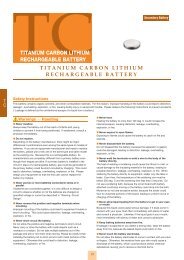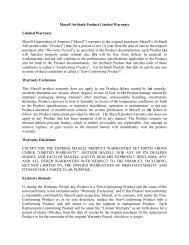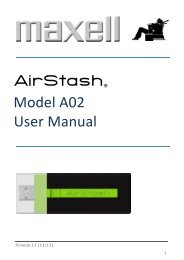Cylindrical CR catalog [PDF 1.61MB] - Maxell
Cylindrical CR catalog [PDF 1.61MB] - Maxell
Cylindrical CR catalog [PDF 1.61MB] - Maxell
Create successful ePaper yourself
Turn your PDF publications into a flip-book with our unique Google optimized e-Paper software.
<strong>CR</strong><br />
LITHIUM MANGANESE DIOXIDE BATTERY<br />
Lithium Manganese<br />
Dioxide Battery (Li/MnO2)<br />
Primary Battery<br />
Safety Instructions<br />
This battery contains lithium, organic solvents, and other combustible materials. For this reason, improper handling of<br />
the battery could lead to distortion, leakage*, overheating, explosion, or fire, causing bodily injury or equipment trouble.<br />
Please observe the following instructions to prevent accidents.<br />
(* Leakage is defined as the unintentional escape of a liquid from a battery.)<br />
Warnings — Handling<br />
Never swallow.<br />
Always keep the battery out of the reach of infants and young children<br />
to prevent it from being swallowed. If swallowed, consult a physician<br />
immediately.<br />
Never charge.<br />
The battery is not designed to be charged by any other electrical<br />
source. Charging could generate gas and internal short-circuiting,<br />
leading to distortion, leakage, overheating, explosion, or fire.<br />
Never heat.<br />
Heating the battery to more than 100 deg. C* could increase the internal<br />
pressure, causing distortion, leakage, overheating, explosion, or<br />
fire. (* Consult <strong>Maxell</strong> regarding heat resistant coin type lithium<br />
manganese dioxide batteries.)<br />
Never expose to open flames.<br />
Exposing to flames could cause the lithium metal to melt, causing<br />
the battery to catch on fire and explode.<br />
Never disassemble the battery.<br />
Do not disassemble the battery, because the separator or gasket could<br />
be damaged, leading to distortion, leakage, overheating, explosion, or<br />
fire.<br />
Never reverse the positive and negative terminals when<br />
mounting.<br />
Improper mounting of the battery could lead to short-circuiting,<br />
charging or forced-discharging. This could cause distortion,<br />
leakage, overheating, explosion, or fire.<br />
Never short-circuit the battery.<br />
Do not allow the positive and negative terminals to short-circuit.<br />
Never carry or store the battery with metal objects such as a<br />
necklace or a hairpin. Do not take multiple batteries out of the<br />
package and pile or mix them when storing. Otherwise, this could<br />
lead to distortion, leakage, overheating, explosion, or fire.<br />
Never weld the terminals or weld a wire to the body of the<br />
battery directly.<br />
The heat of welding or soldering could cause the lithium to melt, or<br />
cause damage to the insulating material in the battery. This could<br />
cause distortion, leakage, overheating, explosion, or fire. When<br />
soldering the battery directly to equipment, solder only the tabs or<br />
leads. Even then, the temperature of the soldering iron must be<br />
below 350 deg. C and the soldering time less than 5 seconds. Do<br />
not use a soldering bath, because the circuit board with battery<br />
attached could stop moving or the battery could drop into the bath.<br />
Moreover do not use excessive solder, because the solder could<br />
flow to unwanted portions of the board, leading to a short-circuit or<br />
charging of the battery.<br />
Never use different batteries together.<br />
Using different batteries together, i.e. different type or used and new<br />
or different manufacturer could cause distortion, leakage,<br />
overheating, explosion, or fire because of the differences in battery<br />
property. If using two or more batteries connected in series or in<br />
parallel even same batteries, please consult with <strong>Maxell</strong> before<br />
using.<br />
Never allow liquid leaking from the battery to get in your eyes<br />
or mouth.<br />
Because this liquid could cause serious damage, if it does come in<br />
contact with your eyes, flush them immediately with plenty of water<br />
and consult a physician. Likewise, if the liquid gets in your mouth,<br />
rinse immediately with plenty of water and consult a physician.<br />
Keep leaking batteries away from fire.<br />
If leakage is suspected or you detect a strong odor, keep the battery<br />
away from fire, because the leaked liquid could catch on fire.<br />
Never touch the battery electrodes.<br />
Do not allow the battery electrodes to come in contact with your skin<br />
or fingers. Otherwise, the moisture from your skin could cause a<br />
discharge of the battery, which could produce certain chemical<br />
substances causing you to receive a chemical burns.<br />
C<br />
R<br />
22
<strong>CR</strong><br />
Primary<br />
Battery<br />
Warnings — Circuit Design for Back-up Use<br />
This is a primary battery and cannot be charged. If used in memory<br />
or RTC back-up applications, be sure to use diodes to prevent<br />
charging from the main power source or other batteries, and a<br />
protective resistor to regulate the current as shown in the figure<br />
below. Note that the points described below should be taken into<br />
careful consideration when selecting diodes and protective resistors.<br />
+5V<br />
Diode<br />
Diode<br />
Protective<br />
resistor<br />
Battery<br />
Load<br />
+5V<br />
Diode<br />
Diode<br />
Diode<br />
Battery<br />
Load<br />
Warnings — Disposal<br />
The battery may be<br />
regulated by national or<br />
local regulation.<br />
Please follow the<br />
instructions of proper<br />
regulation. As electric<br />
capacity is left in a<br />
discarded battery and<br />
it comes into contact<br />
with other metals, it<br />
could lead to<br />
distortion, leakage,<br />
Do not pile up or mix<br />
batteries.<br />
Enlarged view<br />
Electric current flows.<br />
These batteries generate heat.<br />
Tape<br />
+<br />
Battery<br />
(Example of<br />
battery insulation)<br />
overheating, or explosion, so make sure to cover the (+) and (-)<br />
terminals with friction tape or some other insulator before disposal.<br />
—<br />
Example (A)<br />
Supplied voltage to load<br />
Because a diode and a resistor generate the voltage drop on<br />
operating, please take into consideration these voltage drops for<br />
supplied voltage to load.<br />
Using diodes to prevent charging<br />
Please choose diodes with leak current as small as possible. Please<br />
keep the charged capacity due to leak current to within 1% of<br />
nominal capacity.<br />
Using and setting protective<br />
resistors<br />
A protective resistor is used to<br />
prevent the battery from being<br />
charged by large surges of current<br />
during diode failure. Please set the<br />
resistor so that the maximum<br />
current shown in the right table is<br />
not exceeded. For example, say a<br />
<strong>CR</strong>2032 battery is used in sample<br />
circuit (A) in combination with a<br />
main power source 5 volt. Since the<br />
permitted charge current is 10mA<br />
and this battery’s voltage is 3V, let<br />
the resistor be<br />
R> = (5V-3V)/10mA=0.2k ohm,<br />
meaning that at least 0.2k ohm is<br />
required.<br />
Type<br />
<strong>CR</strong>2450HR<br />
<strong>CR</strong>2450HR-Ex<br />
<strong>CR</strong>2050HR<br />
<strong>CR</strong>2450<br />
<strong>CR</strong>2430<br />
<strong>CR</strong>2032H<br />
<strong>CR</strong>2032<br />
<strong>CR</strong>2025<br />
<strong>CR</strong>2016<br />
<strong>CR</strong>1632<br />
<strong>CR</strong>1620<br />
<strong>CR</strong>1616<br />
<strong>CR</strong>1220<br />
<strong>CR</strong>1216<br />
<strong>CR</strong>1025<br />
<strong>CR</strong>17450<br />
<strong>CR</strong>17335<br />
Example (B)<br />
Maximum Current<br />
15mA<br />
15mA<br />
10mA<br />
15mA<br />
15mA<br />
10mA<br />
10mA<br />
10mA<br />
10mA<br />
4.0mA<br />
4.0mA<br />
2.5mA<br />
3.0mA<br />
2.5mA<br />
2.5mA<br />
20mA<br />
20mA<br />
Caution — Handling/Storage<br />
Never expose the battery to ultrasonic sound.<br />
Exposing the battery to ultrasonic sound may cause short-circuiting<br />
because the inside material is broken into pieces, leading to<br />
distortion, leakage, overheating, explosion, or fire.<br />
Never subject the battery to severe shock.<br />
Dropping, throwing or stomping on the battery may cause distortion,<br />
leakage, overheating, explosion, or fire.<br />
Never short-circuit the battery while installing into equipment.<br />
Please be careful when installing the battery not to short-circuit it with<br />
metal portions of the equipment.<br />
Use the correct battery suitable for the equipment.<br />
The battery may not be suitable for the specific equipment due to the<br />
using conditions or type of equipment. Please select the suitable<br />
battery according to the handling instructions of the equipment.<br />
Never use or leave the battery in a hot place such as under the direct<br />
rays of the sun or in a car in hot weather.<br />
If you do, this may cause distortion, leakage, overheating, explosion,<br />
or fire.<br />
Never allow the battery to come in contact with water.<br />
If it does, this may cause the battery to rust or lead to distortion,<br />
leakage, overheating, explosion, or fire.<br />
Never store the battery in a hot and highly humid environment.<br />
Doing so may cause the performance of the battery to deteriorate. In<br />
certain environments, this may lead to distortion, leakage,<br />
overheating, explosion, or fire.<br />
C<br />
R<br />
23<br />
Note: If the diodes broke down, it is necessary for safety to replace<br />
them as soon as possible even though using a protective resistor.<br />
Considering the trouble of diodes and resistors, other safety<br />
measures should be incorporated in the circuit design.<br />
Keep contact pressure more than 2N.<br />
The battery voltage may be lower than intended value because of<br />
poor contact condition, please keep contact pressure more than 2N<br />
for suitable contact resistance.
<strong>CR</strong><br />
Primary Battery<br />
<strong>Cylindrical</strong> Type Lithium Manganese Dioxide Battery<br />
Overview<br />
<strong>Maxell</strong>’s cylindrical type lithium manganese dioxide battery realizes stable discharge characteristics with its original sealing structure, improved<br />
electrical-conductivity structure, and negative electrode material. This battery’s high reliability makes it ideal for use as a power source in industrial<br />
applications such as security devices and electronic meters. Assembled batteries can also be produced to meet special customer requirements.<br />
For details, please contact your nearest <strong>Maxell</strong> dealer or distributor.<br />
Construction<br />
Gasket<br />
Laser Seal<br />
Negative<br />
Electrode<br />
(Li alloy)<br />
Positive Electrode<br />
(MnO2)<br />
Negative Can<br />
Principle and Reactions<br />
Positive Terminal<br />
Gas Release Vent<br />
Collector<br />
(Copper Foil)<br />
Separator<br />
Collector<br />
The cylindrical type lithium manganese dioxide battery uses<br />
manganese dioxide (MnO 2) as its positive active material, and lithium<br />
(Li) as its negative active material.<br />
Battery reactions<br />
Positive reaction: MnO2Li + e – MnOOLi<br />
Negative reaction: Li Li + e –<br />
Total reaction: MnO2Li MnOOLi<br />
Features<br />
Long-term reliability of 10 years*<br />
The employment of a heat-resistant gasket and a laser-seal structure<br />
prevents water intrusion and electrolyte evaporation, ensuring a<br />
long-term reliability of 10 years. The self-discharge rate is about<br />
0.5% per year.<br />
Stable discharge characteristics<br />
The original negative electrode material maintains low internal<br />
resistance even at high depths of discharge and ensures stable<br />
discharge.<br />
Superior low-temperature characteristics<br />
High safety due to internal short-circuit prevention structure<br />
* Designed lifetime at 20 deg. C when not yet used.<br />
Actual lifetime will vary depending on conditions such as discharge current and<br />
temperature.<br />
Applications<br />
Security Devices Communication Tags<br />
ETC (Electronic Toll Collection System)<br />
Home Fire/Smoke Alarms<br />
Electronic Meters (Water, Gas, Electricity)<br />
Memory Backup Power<br />
Products<br />
Model<br />
Nominal Voltage (V)<br />
Nominal Capacity (mAh)**<br />
<strong>CR</strong>17450 A<br />
3<br />
2500<br />
<strong>CR</strong>17335 A<br />
3<br />
1650<br />
UL Recognized Components<br />
The cylindrical type lithium manganese dioxide battery is a UL<br />
(Underwriters Laboratories Inc.) recognized component. (Technician<br />
Replaceable)<br />
Recognized models: <strong>CR</strong>17450 A, <strong>CR</strong>17335 A, <strong>CR</strong>17450, <strong>CR</strong>17335<br />
Certification Number: MH12568<br />
External Dimensions (unit : mm)<br />
Nominal Discharge Current (mA)<br />
Operating Temperature Range (deg. C)<br />
Dimensions* Diameter (mm) X Height (mm)<br />
Weight (g)*<br />
<strong>CR</strong>17450 A VO-T3 <strong>CR</strong>17450 A WK 41 <strong>CR</strong>17335 A VO-T3<br />
* Dimensions and weight are for the battery itself, but may vary<br />
depending on terminal specifications and other factors.<br />
** Nominal capacity indicates duration until the voltage drops down to<br />
2.0V when discharged at a nominal discharge current at 20 deg. C.<br />
• Data and dimensions are just reference values. For further details,<br />
please contact your nearest <strong>Maxell</strong> dealer or distributor.<br />
5<br />
–40 to +85<br />
17 x 45<br />
22<br />
<strong>CR</strong>17335 A WK 11<br />
5<br />
–40 to +85<br />
17 x 33.5<br />
17<br />
C<br />
R<br />
<br />
<br />
<br />
<br />
<br />
<br />
<br />
<br />
<br />
Insulation sleeve<br />
<br />
<br />
<br />
<br />
<br />
<br />
<br />
<br />
<br />
<br />
<br />
<br />
<br />
<br />
<br />
<br />
<br />
<br />
<br />
<br />
<br />
Insulation sleeve<br />
<br />
<br />
<br />
<br />
<br />
<br />
: Tin plating : Horizontal & Through hole Type : Wire connector Type<br />
36
<strong>CR</strong><br />
Primary<br />
Battery<br />
<strong>CR</strong>17450 A2500mAh<br />
Discharge characteristics<br />
Temperature characteristics<br />
3.4<br />
Temperature: 20 deg. C<br />
3.4<br />
Continuous discharge at 40mA<br />
Voltage (V)<br />
3.2<br />
5mA<br />
3.0<br />
40mA<br />
2.8<br />
2.6<br />
200mA<br />
2.4<br />
100mA<br />
2.2<br />
300mA<br />
2.0<br />
0 500 1000 1500 2000 2500 3000<br />
Discharge capacity (mAh)<br />
Voltage (V)<br />
3.2<br />
<br />
3.0<br />
2.8<br />
<br />
2.6<br />
2.4<br />
<br />
2.2<br />
<br />
2.0<br />
0 500 1000 1500 2000 2500 3000<br />
Discharge capacity (mAh)<br />
Pulse discharge characteristics<br />
Voltage (V)<br />
Minimum voltage for 0.1 second of 300mA pulse discharge<br />
3.2<br />
0 year<br />
3.0<br />
2.8<br />
2.6<br />
2.4<br />
Batteries stored for 10 equivalent years*<br />
2.2<br />
<br />
2.0<br />
0 20 40 60 80<br />
Depth of discharge (%)<br />
*After storage for 114 days at 70 deg. C/90%RH<br />
Storage characteristics<br />
Voltage (V)<br />
3.4<br />
3.2<br />
3.0<br />
2.8<br />
2.6<br />
2.4<br />
Discharge current: 5mA, Discharge temperature: 20 deg. C<br />
Initial batteries<br />
Batteries stored for<br />
10 equivalent years**<br />
2.2<br />
Batteries stored for<br />
5 equivalent years*<br />
2.0<br />
0 500 1000 1500 2000 2500 3000<br />
Discharge capacity (mAh)<br />
*After storage for 57 days at 70 deg. C/90%RH **After storage for 114 days at 70 deg. C/90%RH<br />
<strong>CR</strong>17335 AmAh<br />
Discharge characteristics<br />
Voltage (V)<br />
Temperature: 20 deg. C<br />
3.4<br />
3.2<br />
5mA<br />
3.0<br />
2.8<br />
2.6<br />
30mA<br />
2.4<br />
2.2<br />
200mA 100mA<br />
2.0<br />
0 500 1000 1500 2000<br />
Discharge capacity (mAh)<br />
Temperature characteristics<br />
Voltage (V)<br />
Continuous discharge at 30mA<br />
3.2<br />
3.0<br />
20 deg. C<br />
60 deg. C<br />
2.8<br />
2.6<br />
2.4<br />
2.2<br />
0 deg. C<br />
<br />
—10 deg. C<br />
2.0<br />
0 500 1000 1500 2000<br />
Discharge capacity (mAh)<br />
C<br />
R<br />
37<br />
Pulse discharge characteristics<br />
Voltage (V)<br />
3.4<br />
3.3<br />
3.2<br />
3.1<br />
3.0<br />
2.9<br />
Minimum voltage for 0.1 second of 30mA pulse discharge<br />
0 year<br />
Batteries stored for 10 equivalent years*<br />
2.8<br />
<br />
2.7<br />
0 20 40 60 80<br />
Depth of discharge (%)<br />
*After storage for 114 days at 70 deg. C/90%RH<br />
Storage characteristics<br />
Voltage (V)<br />
3.4<br />
3.2<br />
3.0<br />
2.8<br />
2.6<br />
2.4<br />
2.2<br />
Discharge current: 5mA, Discharge temperature: 20 deg. C<br />
Batteries stored for<br />
5 equivalent years*<br />
Batteries stored for<br />
10 equivalent years**<br />
2.0<br />
0 500 1000 1500 2000<br />
Discharge capacity (mAh)<br />
*After storage for 57 days at 70 deg. C/90%RH<br />
Initial batteries<br />
**After storage for 114 days at 70 deg. C/90%RH
Dangerous Goods Transportation Regulations for Lithium Cells and Batteries<br />
Some transportation regulations have been recently revised and will come into effect after Jan. 1, 2013. Revised UN recommendations<br />
require cells and batteries to be manufactured under a quality management program. This requirement has been incorporated into the IMDG<br />
Code and ICAO TI/IATA DRG. <strong>Maxell</strong> factories have been certified for ISO 9001 and therefore meet this requirement.<br />
1) Transportation except by air: Actual operation is the same as before. (see ref.)<br />
2) Air transportation: Former packing instructions 965 and 968 have been divided into Section I (class 9 dangerous goods) and Section II<br />
(exempt from class 9 dangerous goods). The revised packing instructions consist of Section IA, Section IB and Section II. Section IA (class<br />
9 dangerous goods) is almost the same as the former Section I. Former Section II is divided into Section IB (class 9 dangerous goods)<br />
and Section II (exempt from class 9 dangerous goods). The new Section IB covers items that were formerly exempted from regulation<br />
but which must be shipped as class 9 dangerous goods from 2013. A summary is shown in the following table. Please use updated IATA<br />
regulations (54th edition and later) to confirm details.<br />
Lithium Metal<br />
Content<br />
Package<br />
Limits<br />
Technical Instructions for lithium metal batteries (PI 968)<br />
Section Section II Section IB Section IA<br />
Quantity<br />
Cell: ≤ 0.3 g<br />
Battery: ≤ 0.3 g<br />
N/A<br />
Weight 2.5 kg net weight N/A<br />
Cell: ≤ 1.0 g<br />
Battery: ≤ 2.0 g<br />
≤ 2 batteries or<br />
≤ 8 cells<br />
Cell: ≤ 1.0 g<br />
Battery: ≤ 2.0 g<br />
> 2 batteries or<br />
> 8 cells<br />
2.5 kg gross weight<br />
Passenger and cargo aircraft<br />
Classification Exempted Class 9<br />
Cell: > 1.0 g<br />
Battery: > 2.0 g<br />
N/A<br />
2.5 kg net weight (Pass.)<br />
35 kg net weight (Cargo)<br />
Packaging 1.2 M drop test UN performance packaging<br />
Labels<br />
Documents<br />
Note 1) Note 2) Note 3)<br />
Invoice (Air Waybill)<br />
Additional document<br />
Air Waybill<br />
Additional document<br />
Training Adequate instructions DG training<br />
Declaration for DG<br />
Air Waybill<br />
Note 1): Handling label Note 2): Class 9 hazardous label<br />
Note 3): Cargo aircraft only label 1) For USA: Label is required for Section IB or Section IA.<br />
2) Not for USA: Label is required for Section IA and over 2.5 kg of packing weight.<br />
Technical Instructions for lithium ion batteries (PI965)<br />
Section Section II Section IB Section IA<br />
Watt Hour Rating<br />
Package<br />
Limits<br />
Quantity<br />
Cell: ≤ 2.7 Wh<br />
Battery: ≤ 2.7 Wh<br />
N/A<br />
Weight 2.5 kg net weight N/A<br />
Cell: ≤ 20 Wh<br />
Battery: ≤ 100 Wh<br />
≤ 2 batteries or<br />
≤ 8 cells<br />
Cell: ≤ 20 Wh<br />
Battery: ≤ 100 Wh<br />
> 2 batteries or<br />
> 8 cells<br />
10 kg gross weight<br />
Passenger and cargo aircraft<br />
Classification Exempted Class 9<br />
Cell: > 20 Wh<br />
Battery: > 100 Wh<br />
N/A<br />
5 kg net weight (Pass.)<br />
35 kg net weight (Cargo)<br />
Packaging 1.2 M drop test UN performance packaging<br />
Labels<br />
Documents<br />
Invoice (Air Waybill)<br />
Additional document<br />
Air Waybill<br />
Additional document<br />
Training Adequate instructions DG training<br />
Note 4): Cargo aircraft only label: Label is required for Section IA and over 2.5 kg of packing weight.<br />
Declaration for DG<br />
Air Waybill<br />
Note 4)<br />
50
(Ref.)<br />
Except air transportation, the necessary requirements to transport lithium metal batteries or lithium ion batteries as exempted from class<br />
9 dangerous goods (non-restricted goods) are as follows;<br />
1. The minimum requirements to transport lithium metal batteries;<br />
1) For a lithium metal or a lithium alloy cell, the lithium content must not be more than 1 g. For a lithium metal or lithium alloy battery, the<br />
aggregate lithium content must not be more than 2 g.<br />
2) Each cell or battery must be of the type proven to meet the requirement of each test in the UN Manual of Tests and Criteria, 5th<br />
revised edition, Part III, sub-section 38.3.<br />
3) A battery handling label must be displayed on each package. A telephone number must be printed on the label for additional<br />
information.<br />
4) Each consignment must be accompanied by a document for transport with an indication that:<br />
the package contains lithium metal cells or batteries;<br />
the package must be handled with care and that a flammability hazard exists if the package is damaged;<br />
special procedure should be followed in the event that the package is damaged, to include inspection and repackaging if necessary;<br />
and a telephone number for additional information.<br />
5) Each package must be capable of withstanding a 1.2 m drop test.<br />
2. The minimum requirements to transport lithium ion batteries;<br />
1) For lithium ion cells, the Watt-hour rating is not more than 20 Wh. For lithium ion batteries, the Watt-hour rating is not more than 100<br />
Wh. The Watt-hour rating must be marked on the outside of the battery case except for batteries manufactured before January 1,<br />
2009.<br />
2) Each cell or battery is of the type proven to meet the requirement of each test in the UN Manual of Tests and Criteria, 5th revised<br />
edition, Part III, sub-section 38.3.<br />
3) A battery handling label must be displayed on each package. A telephone number must be printed on the label for additional<br />
information.<br />
4) Each consignment must be accompanied by a document for transport with an indication that:<br />
the package contains lithium ion cells or batteries;<br />
the package must be handled with care and that a flammability hazard exists if the package is damaged;<br />
special procedure should be followed in the event the package is damaged, to include inspection and repackaging if necessary; and<br />
a telephone number for additional information.<br />
5) Each package must be capable of withstanding a 1.2 m drop test.<br />
<strong>Maxell</strong> will provide certificates for 1) and 2) as the need arises. Documentation for 3) and 4) needs to be prepared by the customer. If our<br />
package is used for transport, <strong>Maxell</strong> will provide the certificate for 5) as the need arises. However, if the customer's package is used,<br />
the customer must confirm the package can withstand a 1.2 m drop test. Furthermore, even if our package is used for transport, the<br />
telephone number printed on the label must be changed to that of the sender (customer).<br />
51
Certified Management Systems (Japan)<br />
ISO 14001<br />
The <strong>Maxell</strong> group has been certified for the ISO14001 Environmental Management System and has made efforts to reduce environmental<br />
impacts throughout the product lifecycle.<br />
ISO14001<br />
Hitachi <strong>Maxell</strong>, Ltd.<br />
Certificate No.: EC97J1148<br />
Registration Date: December 24, 1997<br />
Recertification Date: December 15, 2011<br />
Certificate Expiry: December 14, 2014<br />
Scope of Registration: Development, design, manufacture, sales and related services<br />
of information media, batteries, parts, devices and electronic appliances<br />
ISO9001<br />
<br />
JQA-0986<br />
ISO9001<br />
HITACHI MAXELL, LTD.<br />
ENERGY DIVISION<br />
MI<strong>CR</strong>O BATTERY DEPARTMENT<br />
Certificate Number: JQA-0986<br />
Registration Date: September 29, 1995<br />
Last Renewal Date: December 19, 2012<br />
Expiry Date: December 18, 2015<br />
Scope of Registration: The design/development<br />
and the manufacture of cylindrical alkaline battery, silver<br />
oxide battery, alkaline button battery, manganese dioxide<br />
lithium battery (coin type and cylindrical type), thionyl chloride<br />
lithium battery, manganese dioxide lithium rechargeable<br />
battery, titanium carbon lithium rechargeable battery and<br />
coin type lithium rechargeable battery.<br />
JQA-3029<br />
ISO9001<br />
HITACHI MAXELL, LTD.<br />
ENERGY DIVISION<br />
LITHIUM ION BATTERY DEPARTMENT<br />
Certificate Number: JQA-3029<br />
Registration Date: January 29, 1999<br />
Last Renewal Date: December 27, 2011<br />
Expiry Date: December 26, 2014<br />
Scope of Registration:<br />
• The design/development and manufacture of lithium-ion<br />
rechargeable battery.<br />
• The design/development and manufacture (outsources)<br />
of lithium-ion rechargeable battery.<br />
ISO/TS 16949<br />
JQA-AU0078<br />
ISO/TS16949<br />
HITACHI MAXELL, LTD.<br />
ENERGY DIVISION<br />
MI<strong>CR</strong>O BATTERY DEPARTMENT<br />
ONO WORKS<br />
Certificate Number: JQA-AU0078<br />
Registration Date: January 7, 2005<br />
Last Renewal Date: January 7, 2011<br />
Expiry Date: January 6, 2014<br />
Remote Supporting Functions: MAXELL EUROPE LTD.<br />
MAXELL CORPORATION OF AMERICA<br />
Scope of Registration: The design/development and manufacture of<br />
manganese dioxide lithium batteries (coin type) for automobile use.<br />
52
NORTH AMERICA / SOUTH AMERICA<br />
<strong>Maxell</strong> Corporation of America<br />
Main Office:<br />
3 Garret Mountain Plaza, 3rd Floor,<br />
Suite #300, Woodland Park, NJ<br />
07424, U.S.A.<br />
Tel: (+1) 973-653-2400<br />
Fax: (+1) 973-653-2450<br />
Web Site:<br />
http://www.maxell-usa.com/<br />
Canada Branch:<br />
237 Romina Drive, Suite 200<br />
Concord, Ontario L4K 4V3, Canada<br />
Tel: (+1) 905-669-8107<br />
Fax: (+1) 905-669-8108<br />
Web Site:<br />
http://www.maxellcanada.com/<br />
<strong>Maxell</strong> Latin America<br />
Plaza Btesh - Calle 50,<br />
Panama City, Panama<br />
Tel: (+507) 269-6291<br />
Fax: (+507) 263-4413<br />
Web Site:<br />
http://www.maxellpan.com/<br />
Hitachi <strong>Maxell</strong>, Ltd.<br />
2-18-2, Iidabashi,<br />
Chiyoda-ku, Tokyo<br />
102-8521 Japan<br />
Tel: (+81) 3-3515-8249<br />
Fax: (+81) 3-3515-8305<br />
Visit our website at: biz.maxell.com<br />
EUROPE<br />
<strong>Maxell</strong> Europe Ltd.<br />
European Headquarters &<br />
UK Sales Office:<br />
Whitebrook Park, Lower Cookham<br />
Road, Maidenhead, Berkshire<br />
SL6 8YA, UK<br />
Tel: (+44) 1628-41-2012<br />
Fax: (+44) 1628-41-2010<br />
E-mail: hq@maxell.eu.com<br />
(European Headquarters)<br />
sales@maxell.eu.com<br />
(UK Sales Office)<br />
Web Site:<br />
http://www.maxell.eu.com<br />
German Branch:<br />
Mollsfeld 2 40670 Meerbusch<br />
Germany<br />
Tel: (+49) 2159-913-0<br />
Fax: (+49) 2159-913-150<br />
E-mail: mdg@maxell.eu.com<br />
French Branch:<br />
15 Rue Des Oziers PA Du Vert Galant,<br />
BP 97091, St Ouen L'Aumone 95 052<br />
Cergy-Pontoise Cedex, France<br />
Tel: (+33) 1-3424-8811<br />
Fax: (+33) 1-3075-5677<br />
E-mail: mfrinfo@maxell.eu<br />
Italian Branch:<br />
Via Dante 2 21100 Varese, Italy<br />
Tel: (+39) 03-3228-1959<br />
Fax: (+39) 03-3228-8691<br />
E-mail: info@maxell.eu<br />
Hungarian Branch:<br />
Magyarorszagi Fioktelepe H-1095<br />
Budapest Mariassy Utca 7 Hungary<br />
Tel: (+36) 1-464-3800<br />
Fax: (+36) 1-464-3801<br />
E-mail: mhu@maxell.eu<br />
ASIA<br />
Hitachi <strong>Maxell</strong> Global, Ltd.<br />
Main Office:<br />
Suites 807-811, 8th Floor, South<br />
Tower, World Finance Centre,<br />
Harbour City, 17 Canton Road,<br />
Kowloon, Hong Kong<br />
Tel: (+852) 2730-9243<br />
Fax: (+852) 2735-6250<br />
E-mail: maxell@maxell.com.hk<br />
Web Site:<br />
http://www.maxell.com.hk/<br />
Vietnam Office:<br />
Room No. 15, Mezzanine Floor,<br />
Sun Wah Tower, 115 Nguyen Hue<br />
Boulevard, District 1, Ho Chi Minh<br />
City, Vietnam<br />
Tel: (+84) 8-3821-9183<br />
Fax: (+84) 8-3821-9181<br />
E-mail: maxellvn@saigonnet.vn<br />
<strong>Maxell</strong> (Shanghai) Trading Co., Ltd.<br />
Main Office:<br />
1801, Plaza 336, No.336, Xi Zang<br />
Middle Road, Shanghai 200001, China<br />
Tel: (+86) 21-3330-3377<br />
Fax: (+86) 21-3330-4001<br />
E-mail: maxell@maxell.net.cn<br />
Web Site:<br />
http://www.maxell.com.cn/<br />
Beijing Office:<br />
1009 Tower3, Beijing International<br />
Center, No 38 Dongsanhuan Bei Road,<br />
Chaoyang District, Beijing 100026,<br />
China<br />
Tel: (+86) 10-8587-0215<br />
Fax: (+86) 10-8587-0238<br />
E-mail: maxell@maxell.net.cn<br />
<strong>Maxell</strong> (Shenzhen) Trading Co., Ltd.<br />
Room 1707, Golden Central Tower 17F,<br />
Jintian Road, Futian District, Shenzhen<br />
518048, China<br />
Tel: (+86) 755-8280-5220<br />
Fax: (+86) 755-8280-5695<br />
<strong>Maxell</strong> Taiwan, Ltd.<br />
14F, No. 111, Sung Chiang Road,<br />
Taipei 104, Taiwan<br />
Tel: (+886) 2-2516-5553<br />
Fax: (+886) 2-2516-4804<br />
E-mail: maxell@maxell.com.tw<br />
Web Site:<br />
http://www.maxell.com.tw/<br />
<strong>Maxell</strong> Asia (Singapore) Pte. Ltd.<br />
Main Office:<br />
10 Anson Road, #25-06, International<br />
Plaza, Singapore 079903<br />
Tel: (+65) 6220-9291<br />
Fax: (+65) 6220-6070<br />
Web Site:<br />
http://www.maxell.com.sg/<br />
Chennai Office:<br />
C/o NICHE BUSINESS CENTRE.<br />
No:10, First Floor, Second Avenue,<br />
Harrington Road, Chetpet, Chennai-600031, India<br />
Tel: (+91) 44-2836-5152<br />
Mumbai Office:<br />
No. 915, IJIMIMA METROLEX, New Link Road,<br />
Malad-West, Mumbai-400064, India<br />
Tel: (+91) 22-3212-8193<br />
Catalog contents accurate as of February 2013.<br />
Data and dimensions are just reference values.<br />
Contents on this <strong>catalog</strong> are subject to change without notice.<br />
Committed to the highest quality assurance management standards as well as responsibility to the environment,<br />
<strong>Maxell</strong>'s Batteries production facilities are accredited with both ISO 9001 and ISO 14001 certifications.<br />
BATTERIES CATALOG(E) HE021-1302 Printed in Japan


![Cylindrical CR catalog [PDF 1.61MB] - Maxell](https://img.yumpu.com/32837016/1/500x640/cylindrical-cr-catalog-pdf-161mb-maxell.jpg)

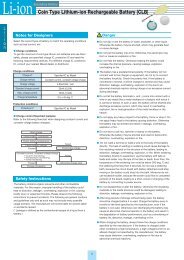


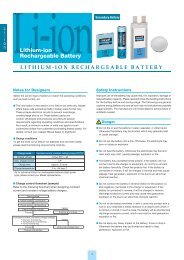
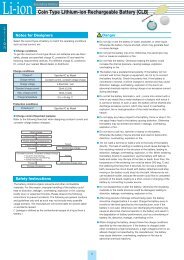
![CLB 电池å•元目录[PDF 1.07MB] - Maxell](https://img.yumpu.com/33415090/1/190x257/clb-aaauaaa-aaaoaaaaaaraa-1-2-aopdf-107mb-maxell.jpg?quality=85)
